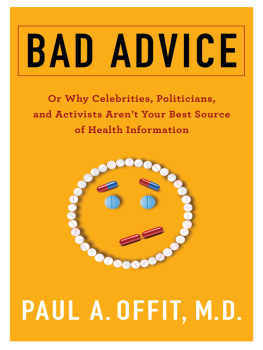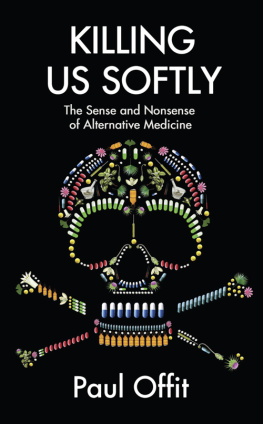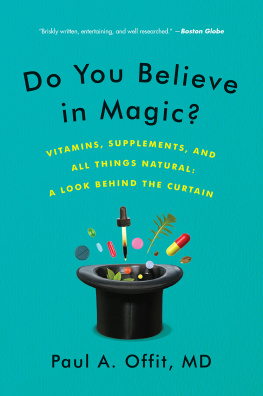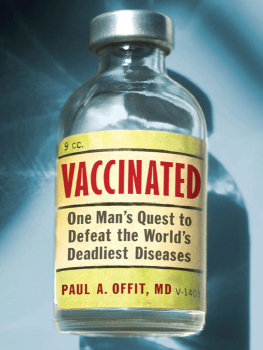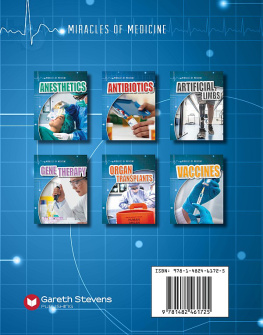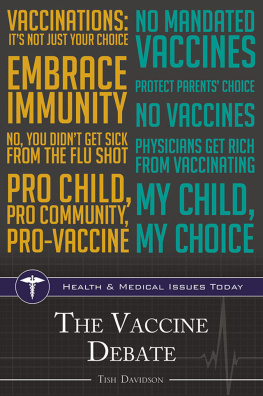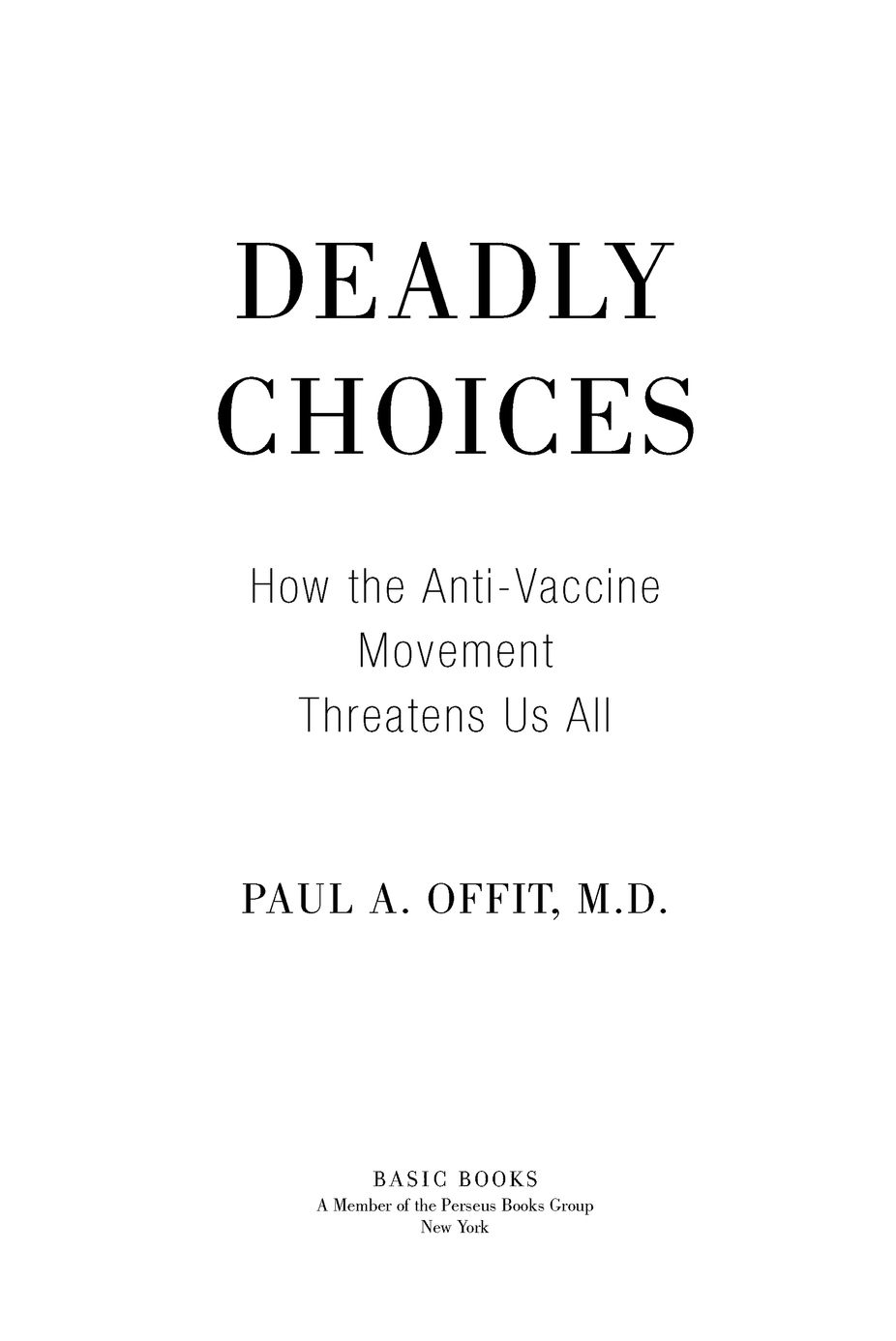Table of Contents
ALSO BY PAUL A. OFFIT, M.D.
Autisms False Prophets
Vaccinated
The Cutter Incident
To Maurice Hilleman and Stanley Plotkin,
who taught me the beauty of reason
and the power of vaccines
The judgment of history is without pity.
RAYMOND ARON
PROLOGUE
Theres a war going on out therea quiet, deadly war.
On one side are parents. Every week theyre bombarded with stories about the dangers of vaccines. They hear that babies get too many vaccines, overwhelming their immune systemsthen they watch them get as many as thirty-five shots in a span of only a few years and sometimes five at one time. They hear that vaccines cause chronic diseases. And they hear this from people they trust: celebrities like Oprah Winfrey, Larry King, Bill Maher, Don Imus, Jenny McCarthy, and Jim Carrey; elected representatives like Carolyn Maloney, Chris Smith, Dave Weldon, and Dan Burton; television correspondents like Sharyl Attkisson of CBS Evening News; and popular doctors like Mehmet Oz and Robert Sears. But mostly they hear it from parents like themselvesparents who claim their children were fine one minute, got a vaccine, then werent fine anymore. Understandably, some parents are backing away from vaccines; one in ten are choosing not to give one or more vaccines. Some arent giving any vaccines at all; since 1991 the percentage of unvaccinated children has more than doubled.
On the other side are doctors. Weary of parents who insist on individualized schedules, scared to send children out of their offices unvaccinated, and concerned that their waiting rooms, packed with unvaccinated children, are becoming a dangerous place, theyre taking a stand. As many as four in ten pediatricians now refuse to see families who dont vaccinate, causing some parents to seek the comfort of doctors or chiropractors more willing to do what they ask.
Caught in the middle are children. Left vulnerable, theyre suffering the diseases of their grandparents. Recent outbreaks of measles, mumps, whooping cough, and bacterial meningitis have caused hundreds to suffer and some to diedie because their parents feared vaccines more than the diseases they prevent.
Amid the confusion, another group has emerged: parents angry that unvaccinated children have put their children at risk. Some of these parents have children who cant be vaccinated. Weakened by chemotherapy for their cancers, or immunosuppressive therapy for their transplants, or steroid therapy for their asthma, these children are particularly vulnerable. They depend on those around them to be vaccinated; if not, theyre the ones most likely to suffer during outbreaks.
Weve come to a crossroads. During the past two decades, as more states have allowed exemptions to vaccination, population immunity has broken down. And the questions have gotten harder. Should states continue to allow parents to opt out of vaccines? Or should they step in and take away that right?
The fear of vaccines, the choice to act on that fear, the consequences of that choice, and the voices rising in protest are the subjects of this book.
INTRODUCTION
All horror movies start the same way. Whether the scene is an abandoned cabin, a dark alley, or a peaceful cottage, one line of dialogue, quietly uttered five minutes before the carnage starts, is inevitable: Did you hear something?
Such is the case with certain infections in American children. On February 17, 2009, Robert Bazell, a science correspondent for NBC Nightly News, told the story of an unusual outbreak in Minnesota: a handful of children had contracted meningitis caused by the bacterium Haemophilus in fluenzae type b, or Hib. What made this outbreak so unusual was that it didnt have to happen; a vaccine to prevent Hib had been around for twenty years. But most of the Minnesota childrenincluding one who died from the diseasewerent vaccinated. The problem wasnt that their parents couldnt afford vaccines, or that they didnt have access to medical care, or that they didnt know about the value of vaccines. The problem was that they were afraid: afraid that vaccines contained dangerous additives; or that children received too many vaccines too soon; or that vaccines caused autism, diabetes, multiple sclerosis, attention deficit disorder, learning disabilities, and hyperactivity. And despite scientific studies that should have been reassuring, many parents werent reassured. When the outbreak was over, one mother reconsidered her decision: The doctor looked at me and said, Your son is going to die. He doesnt have much time. Honestly, I never really understood how severe the risk [was] that we put our son at.
The Minnesota outbreak wasnt an isolated event. In 2008 and 2009, outbreaks of Hib meningitis occurred in Pennsylvania, New York, Oklahoma, and Maine, killing at least four more children; in each case, parents had made the choice not to vaccinatea choice that proved fatal.
Most parents today have probably never heard of Hib. But older doctors certainly remember it; so do grandparents. Before the vaccine, Hib caused meningitis, bloodstream infections, and pneumonia in twenty thousand children every year, killing a thousand and leaving many with permanent brain damage. Todays outbreaks are a fraction of what they were in the past. But, as more parents choose not to vaccinate, more outbreaks of preventable infections are popping up across the country. And more children are needlessly harmed. The phenomenon doesnt seem to be going away. So the questions remain: Have we heard something? Are these outbreaks just a blip on the radar screen? Or do they represent a deeper, far more serious problem?
Hib isnt the only concern. Whooping cough, measles, and mumpsdiseases once easily controlled by vaccinesare also coming back.
Whooping cough (pertussis) is a devastating infection. Before a vaccine was first used in the United States in the 1940s, about three hundred thousand cases of whooping cough caused seven thousand deaths every year, almost all in young children. Now, because of the pertussis vaccine, fewer than thirty children die every year from the disease. But times are changing.
Vashon Island is a small commuter island in King County, Washington. About ten thousand people live there, mostly well educated and affluent. The island supports an elementary school, a middle school, and a high school. Although schools on Vashon Island look like schools in any other upscale community, one difference isnt immediately obvious. About one in seven children on the island is unvaccinated; in the middle school, its one in four. The consequences of this choice first appeared in the early 1990s. In 1994, the children of Vashon Island suffered 48 cases of whooping cough; in 1995, the number increased to 263; by 1999, it was 458.
Although whooping cough often starts benignly, its not a benign disease. Children with whooping cough first suffer congestion, coughing, and runny noses. Then they get the symptom that gives the disease its name. The bacterium that causes whooping cough, Bordetella pertussis, triggers the accumulation of thick, sticky mucus in the windpipe. Children try to rid themselves of the mucus by coughing; but its so gummy and tenacious that its impossible to cough up. Panicking, a child coughs and coughsas many as twenty times in a rowwithout breathing in. Because these coughing spells deprive children of oxygen, many cough until theyre literally blue in the face. The long-awaited breath, taken against a narrowed windpipe, creates an unmistakable high-pitched sound. Parents who hear the whoop of whooping cough never forget it.


